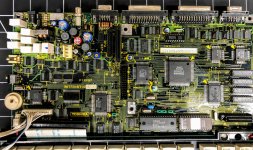I'm also currently working on a T1000 but have a different problem (no worries, I'm not going to hijack this thread).
I'll try to explain a bit on how this PSU works, though I don't think I completely understand it all yet.
In researching and tracing the power supply section I have found that the +5V rail is not actively regulated. It is solely dependant on the presence of the battery clamping the voltage from the 9V powerbrick down to the 4.8 - 5.5V modem7 stated above.
The power from the brick is fed through the large resistors on the top left to limit the current.
Depending on the amount of current required by the system. Some resistors are switched in and out of series based on floppy drive access, modem presense and on/off switch position. These resistors are switched in and out by Q24, Q37 and Q100.
The +5V rail is switched by the 3 MOSFETs grouped together just above R504 (blue 22 Ohm resistor).
These are P-Channel MOSFETs and require the -9V rail to be present to stay on. The whole thing is bootstrapped by Q39 and an SMD transistor (a 2SC3392 marked "AY6") connected to R515/R518 on the bottom of the PCB.
The other power rails for the machine are -22V for the LCD contrast bias and +9V / -9V for RS232/modem.
The -22V and -9V are generated by IC54, which is a TL1451 dual PWM controller which controls two inverting buck/boost topology DC-DC converters.
The +9V is generated using the oscillator from IC54 and a comparator (on of the two in IC30). This is similar to what is happening inside the TL1451, I'm guessing this is a costcutting measure. Later models like the T1200 all use two TL1451's or custom ASICs/Microprocessors.
All three higher supply rails are DC-DC type converters with voltage feedback.
I drew up a schematic of the PSU section which I haven't completely finished nor validated yet, once I'm confident it is correct (and legible) I will post it to my GitHub.
Long story short, the +5V rail jumping up to +7V seems to me as either a short to the +9V rail somewhere or maybe the battery disconnecting on powerup (unlikely seeing how it's wired in).
I would measure the voltages at IC54 (pin 8 is ground, pin 9 is VCC/+5V) and the voltages across C120 (should be +9V) and see wether they make sense.
If you need any more info, let me know. I'd be happy to explain/help further.
Edit: Looking at your picture more thoroughly, is that blue-ish stuff on the tab of Q22 corrosion?
If so, that may be (one of the) problem(s). Q22 is the main switch for the -9V buck/boost converter. Corrosion could have crept in to the package which can damage the transistor.


